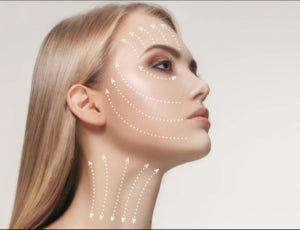Innovative Non-Toxic Skin Healing Solutions

Many of us get to the point where age defiance becomes an important goal. For many, this may mean keeping the body in shape at the gym, ensuring skin suppleness with moisturizes, or using cosmetics to obscure common age-defining features. For others, the goal is to achieve long-lasting and more profound youth-promoting effects, such as facelifts. The facelift is a long known means to overcome the well-known facial aging processes of skin drooping or sagging due to gravitation forces on the skin over time.
There are people who would like to have the effects of a facelift, but simply do not want to “go under the knife” or deal with the risk of general anesthesia for a cosmetic procedure, and the cost of a traditional facelift can be prohibitive. These concerns can be overcome through a procedure that addresses the facial drooping that can lead to a younger-appearing face that does not involve cutting the skin, the longer healing times, and risks associated with traditional surgical approaches. The application of polydioxanone (PDO) threads to lift the facial tissues is a minimally invasive means to achieve similar results as a traditional facelift but with shorter procedure time and less postoperative complications and healing times (1).
*What are PDO threads?
PDO threads are a type of absorbable suture material that is available in different textures (mono, cog, and screw threads). Mono threads have a smooth texture and are used to achieve basic skin tightening. Cog threads have a barbed texture that promotes collagen production and provides a more dramatic lifting effect. Screw threads are typically 2 intertwined threads used to achieve more volume in the areas being treated.
*How are PDO threads used to overcome sagging facial skin?
Unlike the case for traditional surgical facelifts, there is no need for sedation or general anesthesia. Local anesthetic is applied, then a special needle is used to insert the threads beneath the skin surface, lifting it as desired. The typical time for a single outpatient procedure is 45 minutes to an hour. You can then resume your normal activities within one day with some inflammation and swelling lasting about a week. It takes up to 6 months for the body to fully absorb the PDO threads.
*How long do the effects of PDO thread procedures last?
Follow-up treatments may be needed for some people in 6 to 9 months, then another one is typically not needed for another 3 years or so.
*What do PDO thread procedures cost?
PDO procedures cost much less than traditional surgical facelifts, and the exact cost will depend on the scope of the procedure. However, the average cost is in the $2100 range.
PDO threads can also be used in non-facial areas to perform buttock lifts, breast lifts, neck lifts, rhinoplasty (nose job), and general skin tightening procedures. Side effects are minimal and are mostly in the form of post-procedure inflammation that resolves in a week (2, 3). Most experts agree, however, that the best results are in people who do not have very advanced skin changing with significant loss of skin fat and elasticity (1, 3).
References
Comments will be approved before showing up.